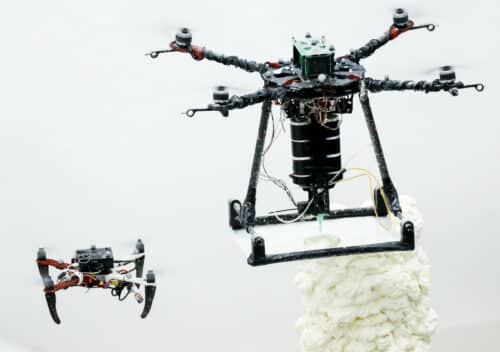Researchers from Imperial College London and Empa have developed flying 3D printers inspired by a fleet of bees that could build and repair structures in-flight

It is difficult and expensive to construct or repair structures due to increasing manual labor costs. Researchers have developed 3D printing drones to build and repair structures while flying, reducing construction costs and risks. This new approach of using 3D printing flying robots also known as drones for construction purposes is inspired by natural builders like bees and wasps that use collective building methods to build their strong and intricate structures.
Lead author Mirko Kovac, Professor at Imperial’s Department of Aeronautics and Head of Empa’s Materials and Technology Center of Robotics, said: “We’ve proved that drones can work autonomously and in tandem to construct and repair buildings, at least in the lab. Our solution is scalable and could help us to construct and repair buildings in difficult-to-reach areas in the future.”
3D printing is having huge demand in the construction industry. The static and mobile robots print materials that are used in construction projects, such as steel and concrete structures. The drones in a fleet, known collectively as Aerial Additive Manufacturing (Aerial-AM), work co-operatively from a single blueprint, adapting their techniques as they go. Aerial-AM involves both a 3D printing and path-planning framework to assist the drones to adapt to variations in the geometry of the structure as a build progresses. For the experimenting purpose, the researchers developed four bespoke cementitious mixtures for the drones to build with.
The fleet consists of BuilDrones, that are used for depositing materials during flight, and quality-controlling ScanDrones are implemented to continuously measure the BuilDrones’ output and inform their next manufacturing steps. They are fully autonomous while flying but are monitored by a human controller who checks progress and intervenes if necessary, based on the drone information.
“Our fleet of drones could help reduce the costs and risks of construction in the future, compared to traditional manual methods,” said Professor Mirko Kovac, Department of Aeronautics & Empa
During the process of building, the drones analyze the printed geometry in real time and adapt their behavior to ensure they met the build specifications. These drones exhibit manufacturing accuracy of five millimeters. This technology provides future possibilities for building and repairing structures in tall, hard-to-access locations.
Professor Kovac said: “We believe our fleet of drones could help reduce the costs and risks of construction in the future, compared to traditional manual methods.”
Click for the Published Research Paper and Demo Video









